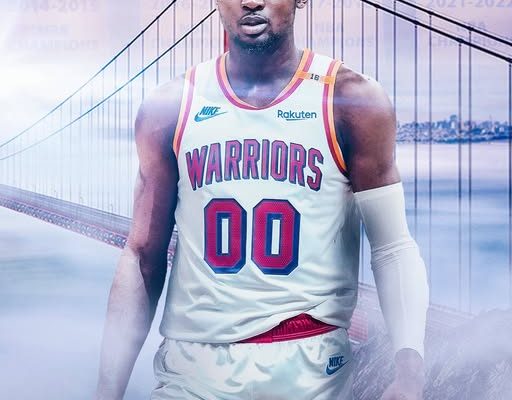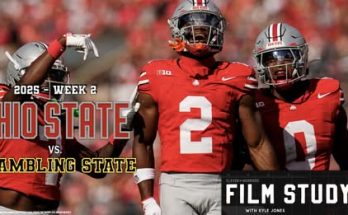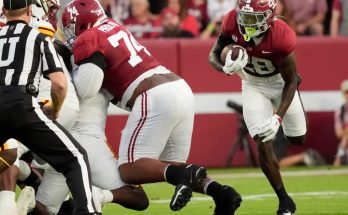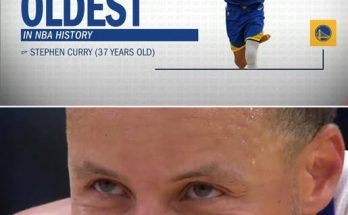Jonathan Kuminga’s name has been swirling around the NBA rumor mill for weeks, but the situation reached an entirely new level when the Golden State Warriors’ promising fourth-year forward reportedly dropped a bombshell on his future with the franchise. According to multiple sources close to the negotiations, Kuminga, who averaged 15.3 points, 4.6 rebounds, and shot 45.4% from the field over 47 games this past season, has made it clear he will not be returning to the Warriors unless the team significantly increases their offer. The 21-year-old forward, known for his raw athleticism and versatility, has already turned down a 5-year, $150 million extension offer, citing a desire for a deal that pays him at least $30 million annually. The rejection of such a massive offer has left the Warriors and the rest of the league stunned, while simultaneously stalling the market for Kuminga, who is currently stuck in restricted free agency.
The Warriors’ front office, led by general manager Mike Dunleavy Jr., has long viewed Kuminga as a crucial piece of their long-term plans, especially given the aging core of Stephen Curry, Klay Thompson, and Draymond Green. However, Golden State’s cap situation is already among the league’s most precarious, with heavy luxury tax penalties looming and an expensive roster that already includes a max contract for Curry, significant salaries for Green, and uncertainty surrounding Thompson’s next deal. Adding Kuminga’s desired $30 million per year to the books could easily push the team deeper into financial territory that ownership may be reluctant to explore, especially with the new collective bargaining agreement imposing harsher penalties for teams that go beyond the second luxury tax apron.
Kuminga’s stance comes at a time when his value as a player is both undeniable and polarizing. On one hand, he has shown flashes of brilliance as a two-way forward, capable of locking down multiple positions defensively while also thriving in transition and providing a scoring punch when needed. His athleticism is among the best in the league, and his upside remains tantalizing for teams looking to invest in a young wing who can grow into a star. On the other hand, some analysts argue that Kuminga’s production, while solid, has yet to reach a level that warrants the type of contract he is demanding. At just 15.3 points per game with relatively limited playmaking and a still-developing three-point shot, some executives around the league are hesitant to commit such a large sum to a player who, while talented, has yet to fully establish himself as a franchise cornerstone.
The Warriors’ offer of $150 million over five years was considered generous by many in the basketball community, given Kuminga’s current resume. By turning it down, the Congolese forward is effectively betting on his ability to prove that he can become one of the league’s premier young forwards. However, with the restricted free agency market drying up, Kuminga’s options are now limited. Teams interested in acquiring him would have to present an offer sheet that the Warriors could match, but with few teams holding significant cap space, the likelihood of him receiving an offer in the range he is seeking is minimal at best.
The tension between Kuminga and the Warriors raises serious questions about Golden State’s immediate and long-term future. The franchise is at a crossroads, attempting to balance its win-now mentality around Curry’s championship window with the development of its younger talent. Kuminga, once viewed as a bridge to the next era of Warriors basketball, could become a casualty of this balancing act if the two sides cannot find common ground. Trading him remains a possibility, but the Warriors would likely demand a significant return, given his youth and upside. The challenge is that potential trade partners are wary of committing to a player with such a high financial expectation before he has fully proven himself.
From Kuminga’s perspective, his stance is as much about role and respect as it is about money. Over his first few seasons, Kuminga has had to fight for minutes in Steve Kerr’s rotation, often finding himself behind veterans in the pecking order, even when his energy and athleticism could have provided a spark. There have been multiple reports of frustration within Kuminga’s camp regarding his inconsistent role, especially during the Warriors’ playoff runs, where Kerr often leaned heavily on experienced players like Andrew Wiggins and Gary Payton II. Kuminga’s belief is that he has outgrown a bench role and deserves to be treated like a foundational piece — both in terms of playing time and contract value.
It is worth noting that Kuminga’s breakout moments have been undeniable. When given consistent minutes, he has demonstrated the ability to score at all three levels, defend the opposing team’s best wing, and provide highlight-reel plays that swing momentum. His athleticism allows him to thrive in transition, and his improvement in mid-range shooting has made him a more well-rounded offensive threat. However, his perimeter shooting, particularly from three-point range, remains a work in progress, and his playmaking ability is still developing. Critics argue that while Kuminga is a great complementary player, he has not yet shown that he can carry an offense or serve as a primary option on a contending team.
The current standoff could have ripple effects across the league. Teams like the Orlando Magic, Oklahoma City Thunder, and Detroit Pistons have been monitoring Kuminga’s situation closely, as they each have young cores and could use a forward of his skill set. However, even these teams are unlikely to shell out $30 million per year without first seeing if Kuminga can sustain high-level production over a full season as a starter. A sign-and-trade scenario is also on the table, where the Warriors could work with another team to facilitate a deal that gives Kuminga the contract he wants while bringing back assets to Golden State. But sign-and-trades are notoriously difficult to negotiate, especially when a player’s market is as uncertain as Kuminga’s.
The financial dynamics of this situation cannot be overstated. The Warriors are one of the most expensive teams in NBA history, and their ownership group, led by Joe Lacob, has already indicated a willingness to pay hefty luxury tax bills to keep the championship window open. However, with new CBA rules designed to limit teams from stockpiling talent by exceeding the second apron, the Warriors’ flexibility is shrinking. Committing $30 million annually to Kuminga would effectively tie up their cap for years to come, making it even harder to build around Curry as he enters the twilight of his career. This creates a difficult decision: Do the Warriors overpay to keep a young player who might blossom into a star, or do they let him walk and risk losing a key piece of their future?
Kuminga’s camp is reportedly confident that he will eventually get the deal he is seeking, either from Golden State or another team. His youth, potential, and flashes of elite-level play give him leverage, but the reality of the NBA market may force him to reconsider his stance if no team is willing to make a strong offer. It is possible that this standoff could drag into the season, with Kuminga signing the Warriors’ qualifying offer and becoming an unrestricted free agent next summer. Such a scenario would put enormous pressure on the Warriors to trade him rather than risk losing him for nothing.
Adding another layer of complexity is the dynamic within the Warriors’ locker room. While Kuminga is well-liked by his teammates, his contract demands and possible departure could create tension within a group that has long prided itself on selflessness and team-oriented culture. Veterans like Curry and Green have been vocal about the importance of maintaining a roster capable of competing for championships, and losing Kuminga — or having him play under a cloud of uncertainty — could disrupt the team’s chemistry. Conversely, paying Kuminga what he wants could set a precedent for future negotiations with other young players, creating a ripple effect the front office may want to avoid.
For Kuminga, this is not just a financial decision but also a statement about his career trajectory. He was drafted seventh overall in the 2021 NBA Draft with the expectation that he would eventually become a key building block for the Warriors’ next era. Over the past three seasons, he has steadily improved, increasing his scoring average and becoming a more reliable defender. Yet, despite his progress, he has not been featured as prominently as some of his draft peers, many of whom are already signing max extensions. Kuminga’s belief is that he is just as capable of being a star, and he wants a contract that reflects that belief.
The Warriors’ offer of $150 million over five years averages $30 million per season, which is in line with the contracts given to several established forwards in the league. The sticking point, according to sources, may not be the annual value but rather the structure of the deal, including incentives, guarantees, and potential options. Kuminga’s camp is reportedly seeking a deal that is both fully guaranteed and structured in a way that signals the team’s commitment to him as a centerpiece moving forward. This demand, combined with Golden State’s financial constraints, has created an impasse that neither side has been able to break.
As the standoff continues, fans and analysts are left wondering what the future holds for both Kuminga and the Warriors. Could this situation escalate to the point where Kuminga forces a trade? Will the Warriors blink first and meet his demands? Or will the market continue to stall, leaving Kuminga with no choice but to compromise? The answers to these questions will have significant implications not just for Golden State, but for the broader NBA landscape. A player of Kuminga’s age and potential rarely becomes available, and if he does, teams around the league will be scrambling to position themselves as suitors.
In the meantime, the Warriors are preparing for a season that could be defined as much by off-court drama as by on-court performance. With Curry still playing at an elite level, the team is determined to maximize what could be the final years of their championship window. However, navigating the Kuminga situation will require both financial ingenuity and a clear vision for the future. If handled poorly, it could mark the beginning of a decline for a franchise that has dominated the NBA for nearly a decade. If handled well, it could secure the Warriors’ status as a contender while setting the stage for a new era led by young stars.



